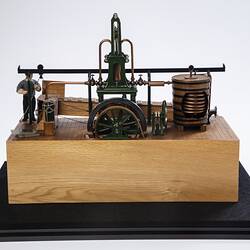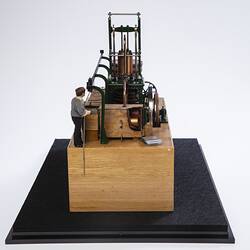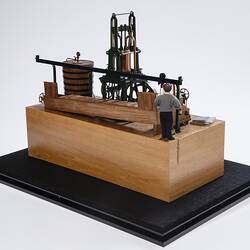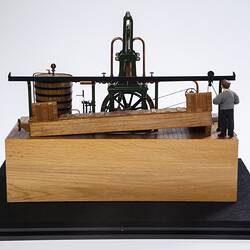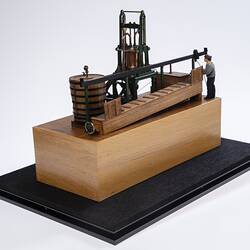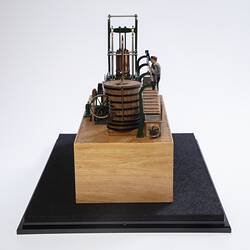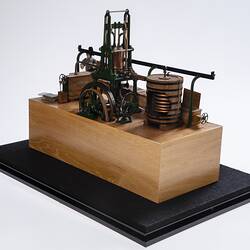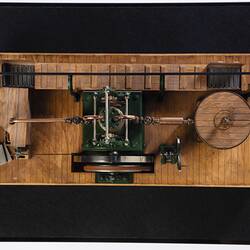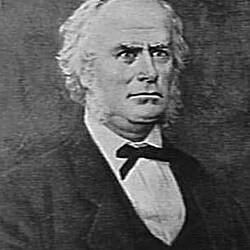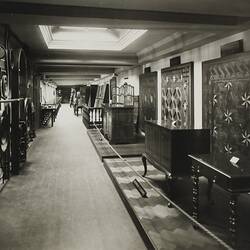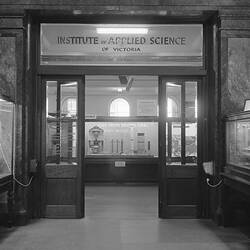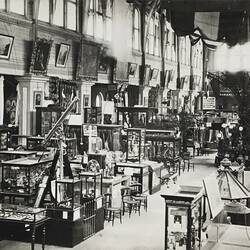Summary
Model of James Harrison's vapour compression refrigeration machine, one of Victoria's few internationally significant inventions of the 19th century.
The type of refrigeration depicted by this model was developed in Geelong, Victoria, by James Harrison (1816-1893), editor of the Geelong Advertiser, in the early 1850s and patented in Australia and Britain in 1856 and 1857. Harrison's concept was further developed and refined by one of London's leading engineering firms into the design that gave industry its first successful commercial-scale ice-making and refrigeration machines, used in breweries, hotels and distilleries throughout Britain, Europe, South America and Australia. Harrison subsequently used machines of this type to pioneer commercial ice-works in Australia and experiment with the freezing of meat for export to Britain.
This working sectioned scale model of Harrison's ether vapour compression refrigeration machine was built for the Smithsonian Institution in 1963 by the firm H. Clarkson & Son of York, England. The model depicts the first successful commercial version of Harrison's invention, produced by the engineering firm Messrs Siebe & Co., of Mason Street, London, in 1857 and described in an article in 'The Engineer', 12th April1861, page 231. This model is based on the machine described in Harrison's British Patent 2362 /1857: "Improvements in apparatus and producing cold by the evaporation of volatile liquids in vacua", applied for 10th September 1857, and sealed 2nd March 1858.
In the centre of the model is the large compressor (which was powered via a transmission belt to a steam powered engine in the original machine) with a tub containing the condenser coils on the right and the evaporator where the ether was vaporised on the left. At the rear is a wooden freezing box through which brine, chilled by the vaporising ether, was circulated from the evaporator by a small pump. Both the condenser and evaporator are sectioned to show the internal components.
When operating as a working model, it was powered by a small electric motor hidden in the wooden base. When it was on display it was operated by a visitor by using a push-button or foot switch, which caused the working parts of the compressor and brine recirculation pump to move.
The model was used as part of an activated display at the Smithsonian Museum from 1964 to 2002, and then was in storage, being no longer required by the organisation. Note that while described as a "working model", it does not actually operate as a refrigerator or contain any refrigerant.
Physical Description
Metal apparatus painted green with large silver wheel at front and copper drum in top section with wooden barrel with cutaway section on right hand side and wooden box with cutaway section on left hand side and long inclined square tube with two lids open containing ice bricks at the back. There is a figure of a man and two ice bricks on the ground on the left hand side. The model sits on a hollow wooden plinth and the silver wheel goes into the plinth with a leather strap. Inside the plinth, there is a motor and instructions on how to activate the model.
More Information
-
Collecting Areas
-
Acquisition Information
Transfer from Division of Industry, Smithsonian Institution, 19 Jun 2008
-
Inventor
-
Patentee
-
Patentee
-
Manufacturer of Item Modelled
Siebe & Co., Engineers, Mason Street, London, England, Great Britain, 1857
The firm Messrs Siebe & Co was founded by Augustus Siebe in 1919, as 'submarine engineers', becoming pioneers in the manufacture of 'closed-helmet' diving suits and associated equipment such as rotary water pumps and air pumps. In the early 1860s, Augustus's sons Daniel and Henry became involved and the business operated as Siebe Bros & Co. for a period before becoming Siebe, Gorman & Co. in 1868, when Augustus's son-in-law William Augustus Gorman joined the firm. -
Modelmaker
H. Clarkson & Son of York, York, England, Great Britain, 1963
-
Inscriptions
On silver wheel: SIEBE ENGINEER / MASON St. LONDON On makers label inside hollow plinth: H. CLARKSON & SON / MODEL ENGINEERS / YORK - ENGLAND
-
Classification
Mechanical engineering, Refrigeration, Refrigeration compressors
-
Category
-
Discipline
-
Type of item
-
Object Measurements
464 mm (Width), 230 mm (Depth), 368 mm (Height)
Measurement of object including plinth base. Length of electrical cord, extends from under base: 1516mm
-
Object Measurements
450 mm (Width), 180 mm (Depth), 238 mm (Height)
Measurement of actual model, not including plinth base. Note: Height measurement taken from top of base to height of model, the central wheel goes inside of base. Dimensions of base only: Width: 458mm; Height: 129mm; Depth: 230mm
-
References
ARTIFICIAL REFRIGERATION (1896, July 23). Illawarra Mercury (Wollongong, NSW : 1856 - 1950), p. 2. Retrieved March 1, 2018, from [Link 1] Jose, Arthur (1923), 'JAMES HARRISON', (1923, September 5). Geelong Advertiser (Vic. : 1859 - 1929), p. 11. Retrieved March 1, 2018, from [Link 2] MR, JAMES HARRISON. (1857, November 6). The Age (Melbourne, Vic. : 1854 - 1954), p. 5. Retrieved March 1, 2018, from [Link 3] THE LATE MR JAMES HARRISON. (1893, September 6). Geelong Advertiser (Vic. : 1859 - 1929), p. 3. Retrieved March 1, 2018, from [Link 4] DEATH OF MR JAMES HARRISON. (1893, September 4). Geelong Advertiser (Vic. : 1859 - 1929), p. 2. Retrieved March 1, 2018, from [Link 5] DEATH OF MR. JAMES HARRISON. (1893, September 4). The Argus (Melbourne, Vic. : 1848 - 1957), p. 6. Retrieved March 1, 2018, from [Link 6] COMPLIMENTARY DINNER TO JAMES HARRISON, ESQ., M.L.C. (1856, March 14). Geelong Advertiser and Intelligencer (Vic. : 1851 - 1856), p. 2 (DAILY.). Retrieved March 1, 2018, from [Link 7] HARRISON'S ICE-MAKING MACHINE. (1861, January 5). Sydney Mail (NSW : 1860 - 1871), p. 2. Retrieved March 1, 2018, from [Link 8] HARRISON'S ICE-MAKING MACHINE. (1860, December 28). The Sydney Morning Herald (NSW : 1842 - 1954), p. 5. Retrieved March 1, 2018, from [Link 9] ICE-MAKING MACHINE. (1858, September 13). Illawarra Mercury (Wollongong, NSW : 1856 - 1950), p. 1. Retrieved March 1, 2018, from [Link 10] 1861, The Engineer, The Engineer v.11 1861 Jan-Jun, "Harrison's Ice-Making Machine", April 12, p 231. The Engineer. London: Morgan-Grampian (Publishers). Retrieved April 12, 2018 from [Link 11]
[Book] Lang, R.W. (Roy). 1982. James Harrison - Pioneering Genius.
[Article] Webster, M. E. 1945. James Harrison 1815-1893. Victorian Historical Magazine. XXI (No.2): 1-13., Vol. XXI, No.2, 1-13 Pages
[Article] Alexander, R. B. 1952. Prominent Personalities of the Eighteen-Fifties - Part (2) James Harrison, M.L.A., Scientific Discoverer and Journalist. Victorian Historical Magazine. XXIV (No.4): 125-126., Vol.XXIV, No.4, 125-126 Pages
-
Keywords
Ice Making Machinery, Innovation & Design, Innovations, Inventors, Models & Modelmaking, Refrigeration, Refrigeration Compressors, Refrigeration Machinery

